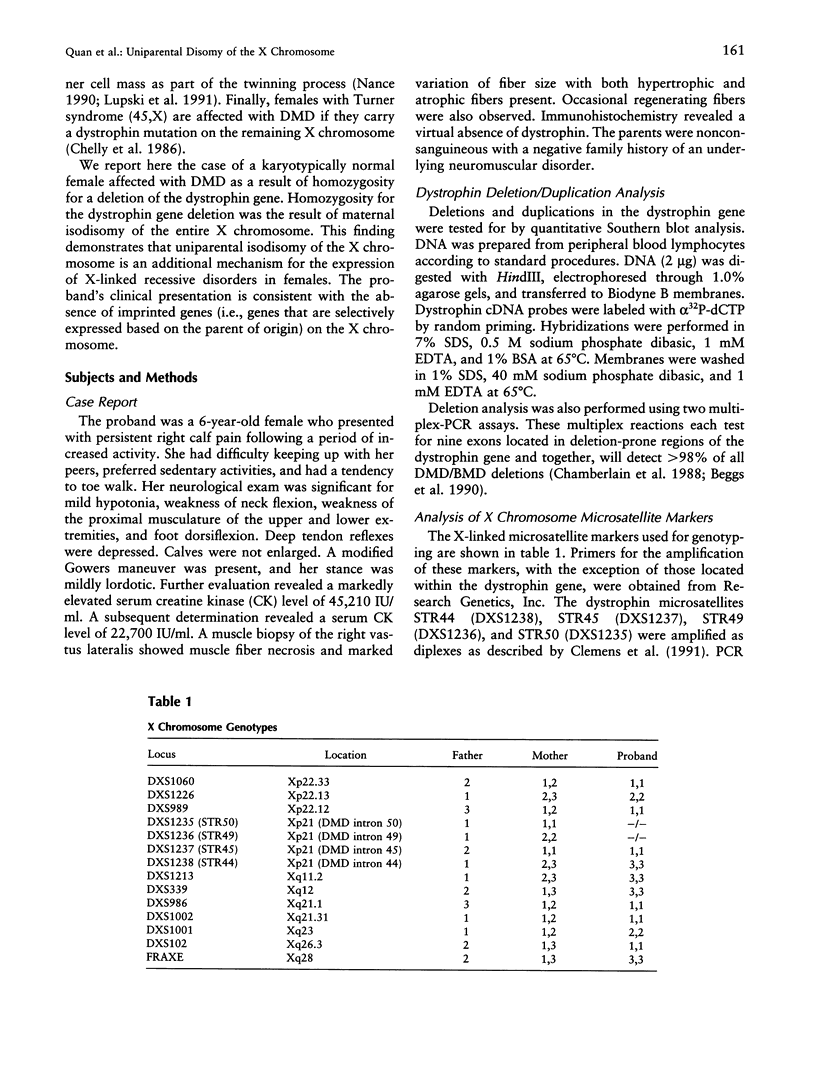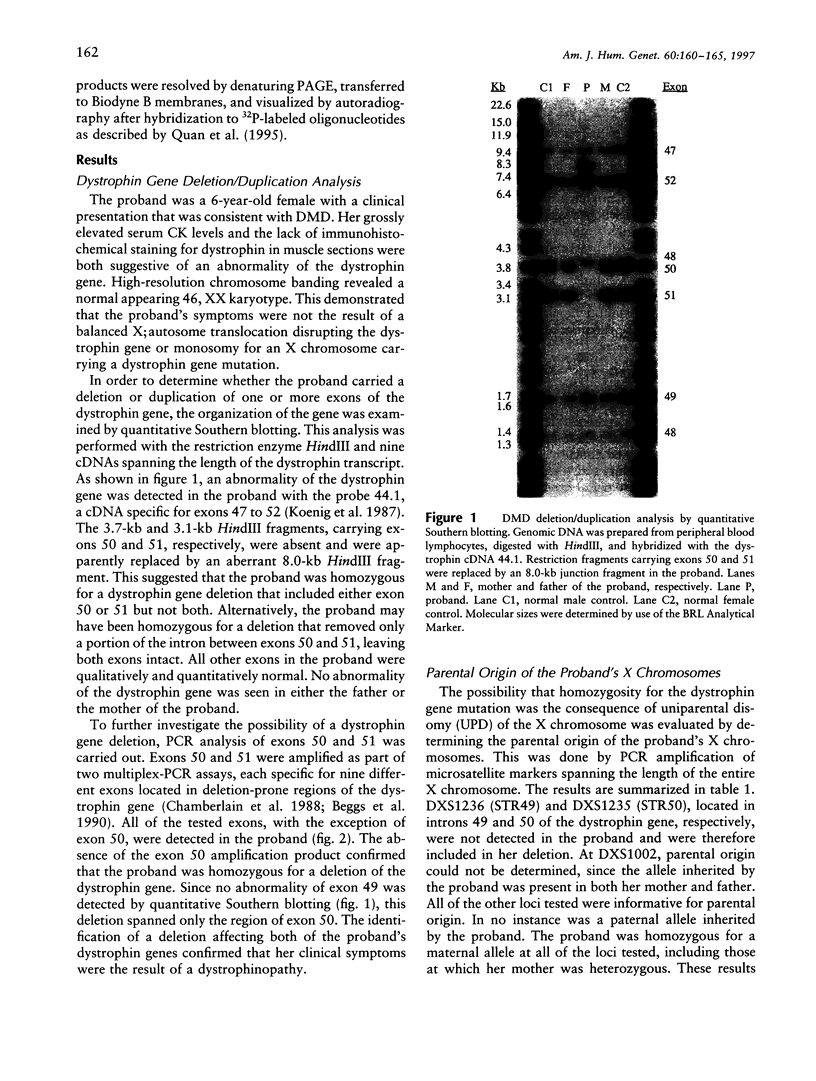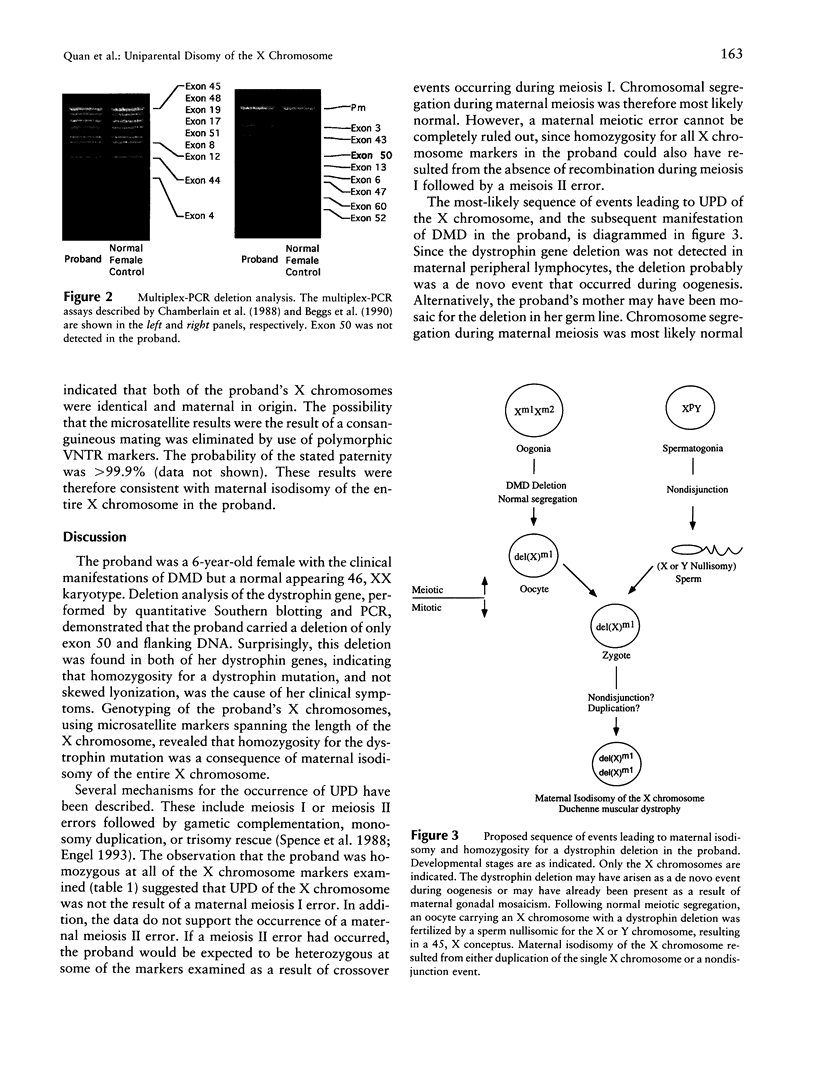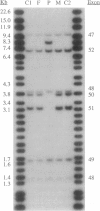Abstract
Duchenne muscular dystrophy (DMD) is a severe, progressive, X-linked muscle-wasting disorder with an incidence of approximately 1/3,500 male births. Females are also affected, in rare instances. The manifestation of mild to severe symptoms in female carriers of dystrophin mutations is often the result of the preferential inactivation of the X chromosome carrying the normal dystrophin gene. The severity of the symptoms is dependent on the proportion of cells that have inactivated the normal X chromosome. A skewed pattern of X inactivation is also responsible for the clinical manifestation of DMD in females carrying X;autosome translocations, which disrupt the dystrophin gene. DMD may also be observed in females with Turner syndrome (45,X), if the remaining X chromosome carries a DMD mutation. We report here the case of a karyotypically normal female affected with DMD as a result of homozygosity for a deletion of exon 50 of the dystrophin gene. PCR analysis of microsatellite markers spanning the length of the X chromosome demonstrated that homozygosity for the dystrophin gene mutation was caused by maternal isodisomy for the entire X chromosome. This finding demonstrates that uniparental isodisomy of the X chromosome is an additional mechanism for the expression of X-linked recessive disorders. The proband's clinical presentation is consistent with the absence of imprinted genes (i.e., genes that are selectively expressed based on the parent of origin) on the X chromosome.
Full text
PDF





Images in this article
Selected References
These references are in PubMed. This may not be the complete list of references from this article.
- Beggs A. H., Koenig M., Boyce F. M., Kunkel L. M. Detection of 98% of DMD/BMD gene deletions by polymerase chain reaction. Hum Genet. 1990 Nov;86(1):45–48. doi: 10.1007/BF00205170. [DOI] [PubMed] [Google Scholar]
- Boyd Y., Buckle V., Holt S., Munro E., Hunter D., Craig I. Muscular dystrophy in girls with X;autosome translocations. J Med Genet. 1986 Dec;23(6):484–490. doi: 10.1136/jmg.23.6.484. [DOI] [PMC free article] [PubMed] [Google Scholar]
- Chamberlain J. S., Gibbs R. A., Ranier J. E., Nguyen P. N., Caskey C. T. Deletion screening of the Duchenne muscular dystrophy locus via multiplex DNA amplification. Nucleic Acids Res. 1988 Dec 9;16(23):11141–11156. doi: 10.1093/nar/16.23.11141. [DOI] [PMC free article] [PubMed] [Google Scholar]
- Chelly J., Marlhens F., Le Marec B., Jeanpierre M., Lambert M., Hamard G., Dutrillaux B., Kaplan J. C. De novo DNA microdeletion in a girl with Turner syndrome and Duchenne muscular dystrophy. Hum Genet. 1986 Oct;74(2):193–196. doi: 10.1007/BF00282093. [DOI] [PubMed] [Google Scholar]
- Clemens P. R., Fenwick R. G., Chamberlain J. S., Gibbs R. A., de Andrade M., Chakraborty R., Caskey C. T. Carrier detection and prenatal diagnosis in Duchenne and Becker muscular dystrophy families, using dinucleotide repeat polymorphisms. Am J Hum Genet. 1991 Nov;49(5):951–960. [PMC free article] [PubMed] [Google Scholar]
- Cooper D. W., VandeBerg J. L., Sharman G. B., Poole W. E. Phosphoglycerate kinase polymorphism in kangaroos provides further evidence for paternal X inactivation. Nat New Biol. 1971 Mar 31;230(13):155–157. doi: 10.1038/newbio230155a0. [DOI] [PubMed] [Google Scholar]
- Engel E. Uniparental disomy revisited: the first twelve years. Am J Med Genet. 1993 Jul 1;46(6):670–674. doi: 10.1002/ajmg.1320460613. [DOI] [PubMed] [Google Scholar]
- Harrison K. B., Warburton D. Preferential X-chromosome activity in human female placental tissues. Cytogenet Cell Genet. 1986;41(3):163–168. doi: 10.1159/000132221. [DOI] [PubMed] [Google Scholar]
- Harrison K. B. X-chromosome inactivation in the human cytotrophoblast. Cytogenet Cell Genet. 1989;52(1-2):37–41. doi: 10.1159/000132835. [DOI] [PubMed] [Google Scholar]
- Jacobs P. A., Betts P. R., Cockwell A. E., Crolla J. A., Mackenzie M. J., Robinson D. O., Youings S. A. A cytogenetic and molecular reappraisal of a series of patients with Turner's syndrome. Ann Hum Genet. 1990 Jul;54(Pt 3):209–223. doi: 10.1111/j.1469-1809.1990.tb00379.x. [DOI] [PubMed] [Google Scholar]
- Koenig M., Hoffman E. P., Bertelson C. J., Monaco A. P., Feener C., Kunkel L. M. Complete cloning of the Duchenne muscular dystrophy (DMD) cDNA and preliminary genomic organization of the DMD gene in normal and affected individuals. Cell. 1987 Jul 31;50(3):509–517. doi: 10.1016/0092-8674(87)90504-6. [DOI] [PubMed] [Google Scholar]
- Ledbetter D. H., Engel E. Uniparental disomy in humans: development of an imprinting map and its implications for prenatal diagnosis. Hum Mol Genet. 1995;4(Spec No):1757–1764. doi: 10.1093/hmg/4.suppl_1.1757. [DOI] [PubMed] [Google Scholar]
- Lupski J. R., Garcia C. A., Zoghbi H. Y., Hoffman E. P., Fenwick R. G. Discordance of muscular dystrophy in monozygotic female twins: evidence supporting asymmetric splitting of the inner cell mass in a manifesting carrier of Duchenne dystrophy. Am J Med Genet. 1991 Sep 1;40(3):354–364. doi: 10.1002/ajmg.1320400323. [DOI] [PubMed] [Google Scholar]
- Migeon B. R., Jeppesen P., Torchia B. S., Fu S., Dunn M. A., Axelman J., Schmeckpeper B. J., Fantes J., Zori R. T., Driscoll D. J. Lack of X inactivation associated with maternal X isodisomy: evidence for a counting mechanism prior to X inactivation during human embryogenesis. Am J Hum Genet. 1996 Jan;58(1):161–170. [PMC free article] [PubMed] [Google Scholar]
- Nance W. E. Do twin Lyons have larger spots? Am J Hum Genet. 1990 Apr;46(4):646–648. [PMC free article] [PubMed] [Google Scholar]
- Pegoraro E., Schimke R. N., Arahata K., Hayashi Y., Stern H., Marks H., Glasberg M. R., Carroll J. E., Taber J. W., Wessel H. B. Detection of new paternal dystrophin gene mutations in isolated cases of dystrophinopathy in females. Am J Hum Genet. 1994 Jun;54(6):989–1003. [PMC free article] [PubMed] [Google Scholar]
- Pentao L., Lewis R. A., Ledbetter D. H., Patel P. I., Lupski J. R. Maternal uniparental isodisomy of chromosome 14: association with autosomal recessive rod monochromacy. Am J Hum Genet. 1992 Apr;50(4):690–699. [PMC free article] [PubMed] [Google Scholar]
- Quan F., Zonana J., Gunter K., Peterson K. L., Magenis R. E., Popovich B. W. An atypical case of fragile X syndrome caused by a deletion that includes the FMR1 gene. Am J Hum Genet. 1995 May;56(5):1042–1051. [PMC free article] [PubMed] [Google Scholar]
- Richards C. S., Watkins S. C., Hoffman E. P., Schneider N. R., Milsark I. W., Katz K. S., Cook J. D., Kunkel L. M., Cortada J. M. Skewed X inactivation in a female MZ twin results in Duchenne muscular dystrophy. Am J Hum Genet. 1990 Apr;46(4):672–681. [PMC free article] [PubMed] [Google Scholar]
- Roberts R. G., Coffey A. J., Bobrow M., Bentley D. R. Exon structure of the human dystrophin gene. Genomics. 1993 May;16(2):536–538. doi: 10.1006/geno.1993.1225. [DOI] [PubMed] [Google Scholar]
- Schinzel A. A., Robinson W. P., Binkert F., Torresani T., Werder E. A. Exclusively paternal X chromosomes in a girl with short stature. Hum Genet. 1993 Sep;92(2):175–178. doi: 10.1007/BF00219687. [DOI] [PubMed] [Google Scholar]
- Sharman G. B. Late DNA replication in the paternally derived X chromosome of female kangaroos. Nature. 1971 Mar 26;230(5291):231–232. doi: 10.1038/230231a0. [DOI] [PubMed] [Google Scholar]
- Spence J. E., Perciaccante R. G., Greig G. M., Willard H. F., Ledbetter D. H., Hejtmancik J. F., Pollack M. S., O'Brien W. E., Beaudet A. L. Uniparental disomy as a mechanism for human genetic disease. Am J Hum Genet. 1988 Feb;42(2):217–226. [PMC free article] [PubMed] [Google Scholar]
- Takagi N., Sasaki M. Preferential inactivation of the paternally derived X chromosome in the extraembryonic membranes of the mouse. Nature. 1975 Aug 21;256(5519):640–642. doi: 10.1038/256640a0. [DOI] [PubMed] [Google Scholar]
- Voss R., Ben-Simon E., Avital A., Godfrey S., Zlotogora J., Dagan J., Tikochinski Y., Hillel J. Isodisomy of chromosome 7 in a patient with cystic fibrosis: could uniparental disomy be common in humans? Am J Hum Genet. 1989 Sep;45(3):373–380. [PMC free article] [PubMed] [Google Scholar]
- Zneimer S. M., Schneider N. R., Richards C. S. In situ hybridization shows direct evidence of skewed X inactivation in one of monozygotic twin females manifesting Duchenne muscular dystrophy. Am J Med Genet. 1993 Mar 1;45(5):601–605. doi: 10.1002/ajmg.1320450517. [DOI] [PubMed] [Google Scholar]




